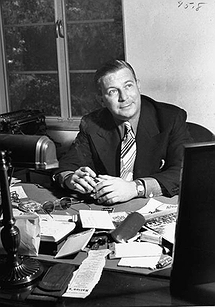به ازای هر نفری که با دعوت شما در منظوم ثبتنام میکنند 20 امتیاز میگیرید.
لینک دعوت:


Hellinger, like the other great Broadway columnist and raconteur 'Damon Runyon', was a purveyor of stories of New York's demimonde, filled with wise-guy jargon. His stories were different from Runyon's, which relied on mythic archetypes, as they featured realistic depictions of actual people. Many of Hellinger's characters were composites of people he met on the Broadway beat.
The realistic cant of Hellinger's stories, as well as their Broadway background made him a natural for the movies. He contributed to the screenplay of Night Court (1932), and Frank Capra's Broadway Bill (1934) was based on one of his stories. His story "The World Moves On" was adapted for the screen as The Roaring Twenties (1939) directed by Raoul Walsh and starring James Cagney and Humphrey Bogart. It was a crime tale whose characters were all based on actual criminals and their fellow travelers during the wide-open era of Prohibition. The success of the film led Warner Brothers to make Hellinger an associate producer.
Although successful, Hellinger grew increasingly unhappy at Warner Brothers over screen credit (specifically on Bogie's It All Came True (1940)) and assorted personal and professional conflicts with Jack L. Warner. 20th Century Fox's Darryl F. Zanuck hired Hellinger away from Warner Brothers in 1941, making him a real producer. Hellinger returned to Warner Brothers before striking out as an independent at Universal, where he produced three seminal and classics of film noir: The Killers (1946) (based on a short-story by fellow newspaperman Ernest Hemingway most recently glossed in David Cronenberg's A History of Violence (2005)), the prison drama Brute Force (1947), and the paradigmatic Big City police drama, The Naked City (1948) , for which Hellinger also voiced the narration.
On December 21, 1947, just as Hellinger was entering into a new independent production company (one of the partners was Humphrey Bogart) he died suddenly at the age of 44. He was buried in Sleepy Hollow Cemetery in Sleepy Hollow, New York. A Broadway Theatre in New York was named for him from 1949 - 1989. The theater has been renamed the Times Square Church.